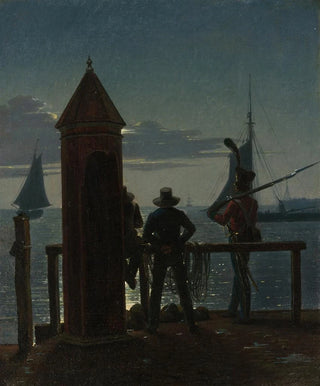Art print | View from the ramparts of the Copenhagen citadel at moonlight - Martinus Rørbye Source: Reproduction | Vue depuis les remparts de la citadelle de Copenhague au clair de lune - Martinus Rørbye


View from behind

Frame (optional)
Art print Vue depuis les remparts de la citadelle de Copenhague au clair de lune - Martinus Rørbye – Introduction captivante
The magic of starry nights and urban landscapes intertwines in the captivating work of Martinus Rørbye, titled "View from the ramparts of Copenhagen's citadel under the moonlight." This canvas, evoking an atmosphere that is both peaceful and mysterious, transports us to a romantic Copenhagen, where the moonlight gently caresses the ancient stones of the citadel. Through this piece, Rørbye succeeds in capturing not only the beauty of the city but also the essence of a suspended moment in time, inviting the viewer to contemplate and marvel at the splendor of a nocturnal landscape.
Style and uniqueness of the work
Rørbye's style is distinguished by his subtle use of light and shadow, creating a striking contrast that brings the scene to life. In "View from the ramparts of Copenhagen's citadel under the moonlight," shades of blue and silver offer a chromatic palette that evokes the serenity of the night, while architectural details of the ramparts and reflections in the water add a dimension of depth and realism. The artist, playing with perspective, manages to give the viewer the impression of being present on these ramparts, observing the city illuminated by the moon. This work, both poetic and realistic, demonstrates Rørbye's mastery in translating emotions through painting.
The artist and his influence
Martinus Rørbye, an emblematic figure of Danish Romanticism, managed to establish his unique style within the 19th-century artistic landscape. Trained at the Royal Danish Academy of Fine Arts in Copenhagen, he was influenced by the great masters of his time, while developing a sensitivity specific to his worldview. His travels across Europe, notably in France and Italy, enriched his repertoire and allowed him to incorporate elements of European landscape painting into his works. Rørbye was able to capture the soul of the places he painted, and "View from the rem

Matte finish

View from behind

Frame (optional)
Art print Vue depuis les remparts de la citadelle de Copenhague au clair de lune - Martinus Rørbye – Introduction captivante
The magic of starry nights and urban landscapes intertwines in the captivating work of Martinus Rørbye, titled "View from the ramparts of Copenhagen's citadel under the moonlight." This canvas, evoking an atmosphere that is both peaceful and mysterious, transports us to a romantic Copenhagen, where the moonlight gently caresses the ancient stones of the citadel. Through this piece, Rørbye succeeds in capturing not only the beauty of the city but also the essence of a suspended moment in time, inviting the viewer to contemplate and marvel at the splendor of a nocturnal landscape.
Style and uniqueness of the work
Rørbye's style is distinguished by his subtle use of light and shadow, creating a striking contrast that brings the scene to life. In "View from the ramparts of Copenhagen's citadel under the moonlight," shades of blue and silver offer a chromatic palette that evokes the serenity of the night, while architectural details of the ramparts and reflections in the water add a dimension of depth and realism. The artist, playing with perspective, manages to give the viewer the impression of being present on these ramparts, observing the city illuminated by the moon. This work, both poetic and realistic, demonstrates Rørbye's mastery in translating emotions through painting.
The artist and his influence
Martinus Rørbye, an emblematic figure of Danish Romanticism, managed to establish his unique style within the 19th-century artistic landscape. Trained at the Royal Danish Academy of Fine Arts in Copenhagen, he was influenced by the great masters of his time, while developing a sensitivity specific to his worldview. His travels across Europe, notably in France and Italy, enriched his repertoire and allowed him to incorporate elements of European landscape painting into his works. Rørbye was able to capture the soul of the places he painted, and "View from the rem






